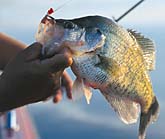|

By Reavis Z. Wortham
A not-so-formal but right-on-the-money education as to the migrations and meanderings of springtime crappie.
We floated to a stop near the fourth bridge support
from the riprap - gads I love that word. "We'll tie up here,"
Wally Marshall said.
In my opinion Marshall is the best crappie fisherman
in the state, and maybe the nation. He's proven his expertise
time and again by winning crappie tournaments, such as first place
in the Crappie USA competition Pro Division on Lake Eufala last
year. I've depended on him for a decade to help me find fish.
"Tie on one of those gray jigs there and we'll
fish against the pilings," he said.
I examined the gray objects within a tightly closed
sandwich bag. "This one?"
Marshall stifled a retch. "No, those are the
Vienna sausages I lost a couple of months ago. They must have
been aging in that drybox for weeks. The gray jigs are in the
other bag."
Selecting a jig, I tied my typical knot - granny
- to attach the lure. "Exactly why do we use the gray ones?"
I asked, thinking he would dazzle me with a deluge of information
about Ph, water temperature and how to read solunar tea leaves.
"Do the fish hit gray Blakemore Roadrunners because they
look like baitfish? Or is it because they prefer gray this time
of the year when the water temperature is above 65 degrees, or
..."
"No," Marshall cut me off with a disgusted
look - I'm not sure if it was for the questions or the granny
knot. "We're using them today because they're the only ones
I had."
I decided right then to learn more about crappie
and the methods used to catch them during the year, especially
in the springtime. I'd been relying on experienced anglers for
too long and it was time for me to graduate.
 Bruce Hysmith, Texas fisheries biologist, set me
straight on several aspects of springtime crappie. "Everything
hinges on temperature," he said hurriedly, to get me off
the telephone, I think. "Crappie are more sensitive to changes
in the thermocline than any other freshwater fish. They become
active once the temperature hits the 40s." Bruce Hysmith, Texas fisheries biologist, set me
straight on several aspects of springtime crappie. "Everything
hinges on temperature," he said hurriedly, to get me off
the telephone, I think. "Crappie are more sensitive to changes
in the thermocline than any other freshwater fish. They become
active once the temperature hits the 40s."
Springtime is for novices and experts alike. Inexperienced
anglers soon realize that the different phases and stages of crappie
fishing, for both the black and white species, are an important
consideration to finding the gregarious fish.
Many Texas anglers know potential crappie filets
are found in less water than it takes to brush your teeth when
the spawn is in full swing, but what about the rest of the time?
A little education goes a long way, eliminating the shotgun approach
to hit-and-miss jigging until something down below takes your
bait.
Ready to begin, class? Remember this if nothing
else. Crappie spawn in 1 to 8 feet of water between 55 and 68
degrees - 64-68 is best. This is usually during the middle of
April here in the Lone Star State.
The stages are predicable and easy to remember.
Pre-spawn is simple. Black crappie are sometimes 25 and 30 feet
deep in early spring. "I've found them suspended in water
that's only two or three degrees warmer than the layer below,"
Marshall said. "Crappie believe in their comfort, and if
you can find an overriding warm layer they won't even need physical
structure to hold.
"In later weeks I'll look for shallow water
in the lake that gets a lot of sun. They'll be stacked up out
there like cordwood. Another place they like is the sunny side
of concrete bridge pilings, or against rocky shores which warm
quickly during the day."
The fish move vertically as the lake water warms,
rising from one level to the next and suspending over channel
drop-offs alongside submerged structure. When the mood strikes,
they begin to move laterally toward the optimum structure for
spawning in shallow water.
Their nomadic progress follows traditional migration
routes, but crappie won't cross large, open flats devoid of cover.
Crappie follow creek channels and structure leading from deep
to shallow water. Successful anglers carefully watch depthfinders;
looking for fish suspended at various depths, awaiting the next
fishy signal only they know and recognize.
Then the action heats up along with the temperature.
White crappie, on the other hand, can always be
found from late February through April in feeder creek channels,
holding in 6 to 20 feet of water and merely tolerating water in
the mid- to high 40s. But once it warms they bury themselves to
their eyeballs in thick growths of willows in the mouths of creeks.
Here they stack up and wait for conditions to become agreeable
before moving out to the spawning beds on the flats, near deep
water.
continued
page 1 / page 2
| 




